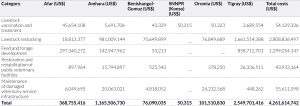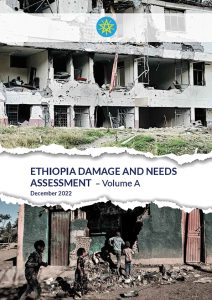Insights
Insight Summary on Productive Sectors Economic Damage – Agriculture Sector
Ethiopia Damage & Needs Assessment, Volume A
Agriculture Sector Analysis, and Pre-conflict Baseline
The agriculture sector is a major contributor to the national GDP. The real GDP of Ethiopia at constant prices in 2020/21 was US$45.54 billion, of which agriculture and allied activities contributed US $15.6 billion (NBE 2021) Near to 34.4%.
Damages to the agriculture sector comprise costs associated with missed production opportunities and actual damages to crops—sustained in the fields and in storage—as well as damages and losses in livestock production.
Conflict impacts: The crop production subsector
The conflict has caused the destruction and damage of various agriculture sector assets and infrastructure, including crops and agricultural inputs.
The total damages and economic losses to the crop subsector explained above amount to about US$11.84 billion, of which damages are estimated at US$8.06 billion and losses at US$3.78 billion (See Table 6.1). It is believed that the losses would be much higher had the damage and needs assessment considered and quantified the opportunity cost associated with farmers being drawn into the conflict and the displacement of other farmers.

TABLE 6.10. Estimated Costs (US$, millions) of Total Needs for the Agriculture Sector, by Recovery Phase
Investment needs: Crop production subsector recovery and reconstruction needs
Recovery needs for the provision of agricultural inputs include investments in farm tools for fast response, replacement of agricultural machinery, rehabilitation of damaged irrigation systems, replacement of irrigation pumps, reconstruction/rehabilitation, and the equipping of fruit nurseries and watering points. In total, an estimated US$1.48 billion is required to meet these investment needs (table 6.7).

TABLE 6.7. Estimated Investment Needs (US$) for Recovery of Crop Production Inputs and Irrigation Systems, by Region
Conflict impacts on the livestock subsector
The conflict-affected areas in most parts of Amhara, Benishangul-Gumuz, Oromia, the SNNPR (Konso), and Tigray practice mixed crop-livestock systems. In Afar, the pastoral system depends heavily on livestock production and productivity. The conflict has caused huge damages and economic losses in livestock production and livestock-related infrastructure.
Livestock subsector recovery and reconstruction needs
The total cost of the recovery and reconstruction of the livestock subsector is estimated at US$4.26 billion. The largest proportion of investment (65.9 percent) is needed for the restocking of animals, followed by the development of feed and forage (30.5 percent).

TABLE 6.9. Estimated Investment Needs (US$) for Recovery and Reconstruction of Livestock Subsector, by Region
The two most conflict-affected regions, Tigray and Amhara, account for 87 percent of the investment needs. The remaining 13 percent could be allocated to the other three regions. Table 6.9 summarizes the estimated costs for the recovery and reconstruction of the livestock subsector by region.
Livestock restocking and livestock health
The largest restocking resource is requested by the Tigray and Amhara regions, which have reportedly incurred severe losses in terms of livestock numbers. In either case, the restocking is expected to be completed within 12 months.
Since vaccination and treatment of animals is a routine and regular activity, it is expected to be done as early as possible through the timely procurement of veterinary supplies and drugs.
Feed and forage development
Feed development is expected to be implemented immediately. Seeds need to be procured, and ready for planting, and the land prepared in good time before the commencement of the rainy seasons. Balers and other harvesting machinery can be purchased one year from now.
Poultry feed can also be procured and made available immediately.
Restoration, rehabilitation, and maintenance of veterinary facilities and other livestock-related infrastructure Restoration and rehabilitation of veterinary facilities with minor losses can be done within 12 months, through the purchase of supplies and equipment that are essential to the functioning of the facilities. A longer time frame of one year or more is required for the maintenance and reconstruction of damaged veterinary service infrastructure, livestock markets, pastoral training centers, abattoirs, and woreda agricultural offices since the damages are large in number.
The recovery and reconstruction effort requires financial resources & the enhanced mobility of skilled human resources from across Ethiopia, and the strengthening of existing institutions in the affected regions, facilitated by an appropriate policy to promote the building of better principles.
The impacts of the agriculture sector damages and losses are not geographically limited to those regions directly affected by the conflict they transcend regional borders and affect the entire nation.
In terms of priorities, urgent attention should be placed on restoring the function of agricultural support services (including agricultural offices and extension posts) and facilitating quick access for farmers to farm implements and agricultural inputs to ensure that farm operations occur on time before another cropping season is lost which would have severe consequences.
Mobilization and deployment of experts and resources in each region are needed, as well as support from federal agencies and development partners. In parallel, as most farm household assets and reserves have been lost during the conflict, social security measures (food assistance, cash transfers, and so on) should be implemented to sustain households until the next crop harvest.


